Month in Review, NASA’s JPL, November 2021 Skywatching, The Orbit of Asteroid Didymos, How NASA’s Curiosity Rover Is Making Mars Safer for Astronauts, First 3D View of Jupiter Atmosphere, Triumph at Saturn, PBS new and NBC News
JPL News – Month in Review, NASA’s Jet Propulsion Laboratory, Tuesday, November 2, 2021
What’s Up: November 2021 Skywatching Tips from NASA
The Orbit of Asteroid Didymos, Nov 17, 2021
How NASA’s Curiosity Rover Is Making Mars Safer for Astronauts, Nov 15, 2021
NASA’s Juno: Science Results Offer First 3D View of Jupiter Atmosphere, Oct 28, 2021
Catch the premiere of the NASA Jet Propulsion Laboratory documentary “Triumph at Saturn” on Oct. 15 at 3 p.m. PDT online at JPL’s YouTube and Facebook channels.
PBS NewsHour full episode, Nov. 19 & 20, 2021
Nightly News Full Broadcast – Nov. 19 & 20, 2021
JPL News – Month in Review
Tuesday, November 2, 2021 |
|
|||||||||||||||||||||||||||||||||||||||||||||||
|
|
||||||||||||||||||||||||||||||||||||||||||||||||
|
||||||||||||||||||||||||||||||||||||||||||||||||
This message was sent to ingpeaceproject@gmail.com from jplnewsroom@jpl.nasa.gov
NASA’s Jet Propulsion Laboratory
NASAJPL
4800 Oak Grove Dr
Pasadena, CA 91109
What’s Up: November 2021 Skywatching Tips from NASA
Nov 2, 2021 NASA Jet Propulsion Laboratory
What are some skywatching highlights in November 2021? Enjoy the Moon and planets after sunset all month, plus a lunar eclipse! A partial lunar eclipse will be visible to much of the world on Nov. 18 and 19. Also, the familiar stars of Northern Hemisphere winter (or Southern summer) are returning to late night skies. In particular, note that several destinations of NASA’s Lucy mission are located near the Pleiades. Additional information about topics covered in this episode of What’s Up, along with still images from the video, and the video transcript, are available at https://solarsystem.nasa.gov/whats-up….
Enjoy the Moon and planets after sunset all month, plus a lunar eclipse! A partial lunar eclipse will be visible to much of the world on Nov. 18 and 19. Also, the familiar stars of Northern Hemisphere winter (or Southern summer) are returning to late night skies. In particular, note that several destinations of NASA’s Lucy mission are located near the Pleiades.
Transcript:
What’s Up for November? Sunset planets, a partial lunar eclipse, and the return of the winter stars.
From November 6th through the 11th, watch the Moon glide past Venus, Saturn, and Jupiter after sunset in the south/southwest. In particular, if you step outside for a look on November 7th, you’ll find the four-day-old crescent Moon just about 2 degrees away from Venus. Should be really pretty, so don’t miss it.
And from now through early December, you’ll find Jupiter and Saturn drawing a little closer to Venus each night.
A partial lunar eclipse is on the way, taking place overnight on November 18th and 19th, when the Moon slips into Earth’s shadow for a couple of hours. Weather permitting, the eclipse will be visible from any location where the Moon appears above the horizon during the eclipse. Depending on your time zone, it’ll occur earlier or later in the evening for you.
Now that’s a huge swath of the planet that’ll be able to see at least part of the eclipse, including North and South America, Eastern Asia, Australia and the Pacific Region. So check the timing of its visibility for your area.
For U.S. East Coast observers, the partial eclipse begins a little after 2 a.m., reaching its maximum at 4 in the morning. For observers on the West Coast, that translates to beginning just after 11 p.m., with a maximum at 1 a.m.
Partial lunar eclipses might not be quite as spectacular as total lunar eclipses – where the Moon is completely covered in Earth’s shadow – but they occur more frequently.
And that just means more opportunities to witness little changes in our solar system that sometimes occur right before our eyes.
All month long, if you’re up late and cast your gaze toward the east, you’ll notice some familiar companions have begun rising late in the night. The familiar stars of Northern winter skies are returning, rising late at night and sitting high in the south by dawn.
You’ll find the Pleiades star cluster leading the constellations Taurus the bull and the hunter Orion, followed by the brightest star in the sky, Sirius – all of them back to keep us company on the long winter nights here in the Northern Hemisphere. (And for those in the Southern Hemisphere, they’re keeping you company on shorter nights as spring gives way to summer there.)
A fun note about the Pleiades this month is that several of the 8 asteroids to be visited by NASA’s Lucy mission are located in that part of the sky. The Lucy spacecraft launched on Oct. 16th on its 12-year mission to visit a bunch of special asteroids called the Trojans. They share the orbit of Jupiter, with a group of them leading the planet, and another group following behind it.
Lucy will be the first space mission to explore this unique group of asteroids, providing new insights about the formation and early history of our solar system.
Here are the phases of the Moon for November. You can catch up on all of NASA’s missions to explore the solar system and beyond at nasa.gov. I’m Preston Dyches from NASA’s Jet Propulsion Laboratory, and that’s What’s Up for this month.
For more information, please visit the following link
https://www.youtube.com/watch?v=fzeK4TcOSPU
The Orbit of Asteroid Didymos
Nov 17, 2021
This diagram shows the orbit of binary asteroid Didymos around the Sun. Didymos consists of a large, nearly half-mile-wide (780-meter-wide) asteroid orbited by a smaller, 525-foot-wide (160-meter-wide) asteroid, or moonlet. Didymos’ orbital path around the Sun is shown as the thin white ellipse and Earth’s orbit is the thick white line. In the background are the orbits for 2,200 other known potentially hazardous asteroids.
A potentially hazardous asteroid is classified as an asteroid wider than about 460 feet (140 meters) with an orbit that brings it within 5 million miles (8 million kilometers) of Earth’s orbit.
Didymos’ smaller asteroid is the target of NASA’s Double Asteroid Redirect Test (DART) mission. The DART spacecraft is a kinetic impactor designed to collide with the moonlet to see how its orbit around the larger asteroid will be changed by the impact. The outcome of this mission will help NASA determine whether the method could be used to modify the trajectory of an asteroid should one threaten Earth in the future. Didymos is not a danger to our planet.
This orbital diagram was produced by the Center for Near Earth Object Studies (CNEOS), which is managed by NASA’s Jet Propulsion Laboratory in Southern California. CNEOS characterizes every known near-Earth asteroid (NEA) orbit to improve long-term impact hazard assessments in support of NASA’s Planetary Defense Coordination Office (PDCO).
For more information, please visit the following link
https://www.jpl.nasa.gov/images/the-orbit-of-asteroid-didymos
How NASA’s Curiosity Rover Is Making Mars Safer for Astronauts
Nov 15, 2021
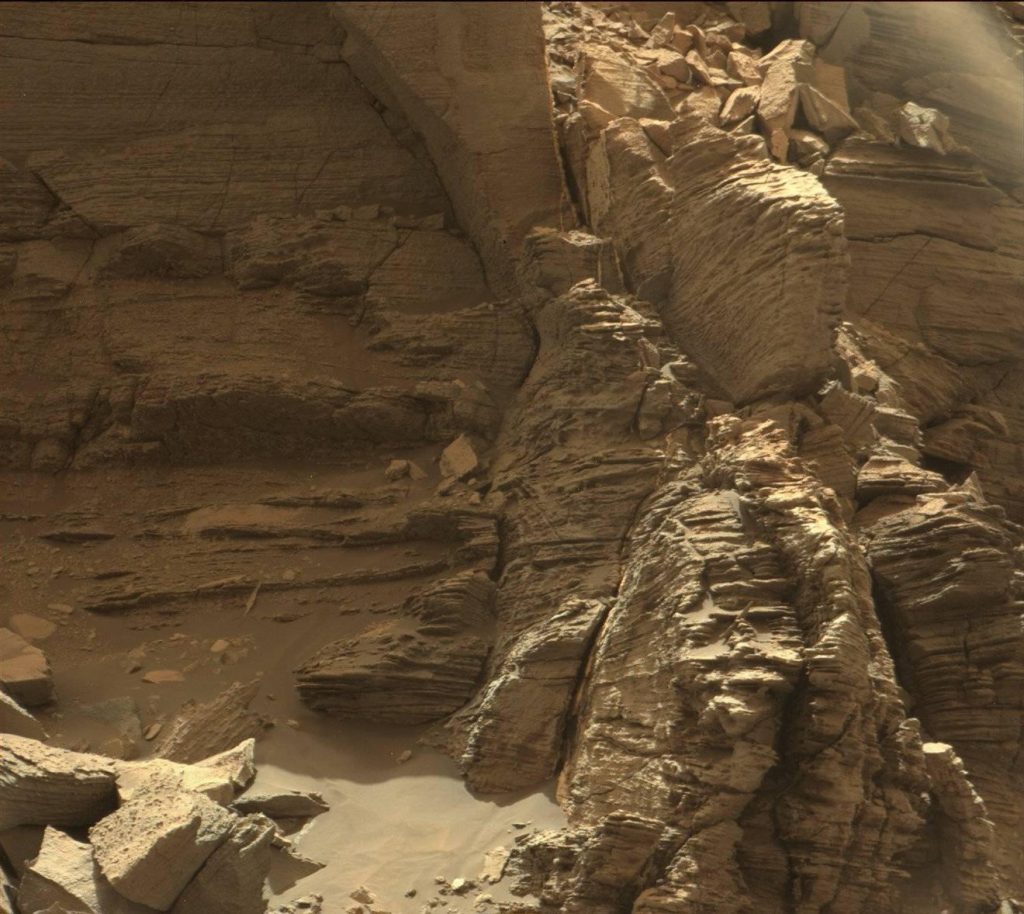 NASA’s Curiosity Mars rover used its Mast Camera, or Mastcam, to capture this image of an outcrop with finely layered rocks within the “Murray Buttes” region on lower Mount Sharp on Sept. 8, 2016. Credit: NASA/JPL-Caltech/MSSS Full Image Details
NASA’s Curiosity Mars rover used its Mast Camera, or Mastcam, to capture this image of an outcrop with finely layered rocks within the “Murray Buttes” region on lower Mount Sharp on Sept. 8, 2016. Credit: NASA/JPL-Caltech/MSSS Full Image Details
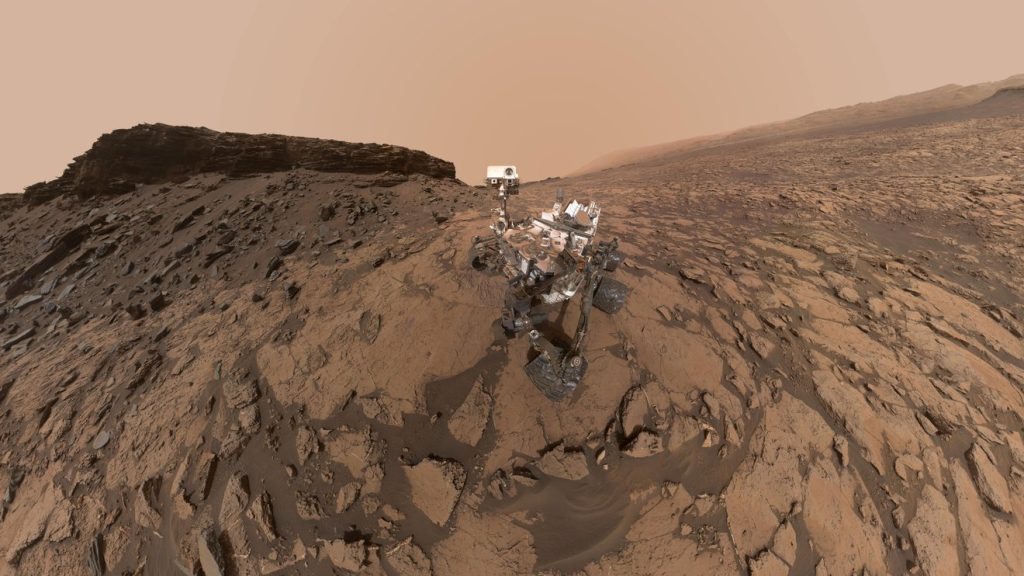 NASA’s Curiosity Mars rover used its Mars Hand Lens Imager, or MAHLI, to take this selfie at the “Quela” drilling location in the “Murray Buttes” area on lower Mount Sharp between Sept. 17 and 18, 2016. Credit: NASA/JPL-Caltech/MSSS Full Image Details
NASA’s Curiosity Mars rover used its Mars Hand Lens Imager, or MAHLI, to take this selfie at the “Quela” drilling location in the “Murray Buttes” area on lower Mount Sharp between Sept. 17 and 18, 2016. Credit: NASA/JPL-Caltech/MSSS Full Image Details
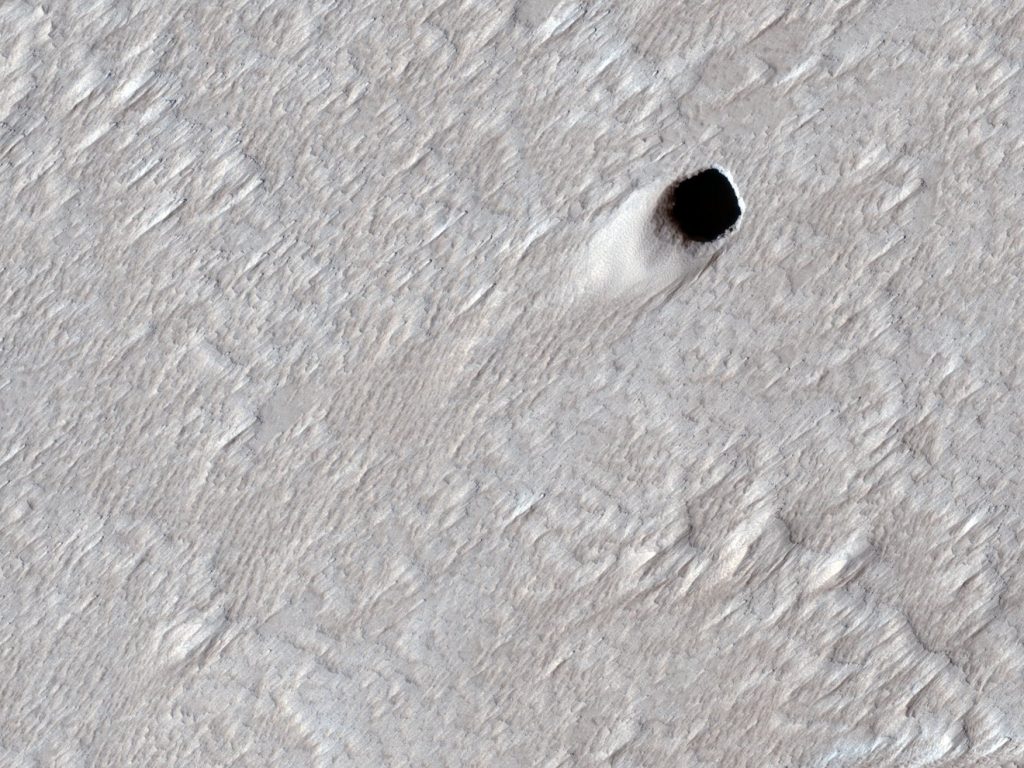 This pit crater was created by an empty lava tube in Mars’ Arsia Mons region. The image was captured by NASA’s Mars Reconnaissance Orbiter on Aug. 16, 2020.
This pit crater was created by an empty lava tube in Mars’ Arsia Mons region. The image was captured by NASA’s Mars Reconnaissance Orbiter on Aug. 16, 2020.
Credit: NASA/JPL-Caltech/University of Arizona
A radiation sensor aboard the spacecraft is providing new data on the health risks humans would face on the surface.
Could lava tubes, caves, or subsurface habitats offer safe refuge for future astronauts on Mars? Scientists with NASA’s Curiosity Mars rover team are helping explore questions like that with the Radiation Assessment Detector, or RAD.
Unlike Earth, Mars doesn’t have a magnetic field to shield it from the high-energy particles whizzing around in space. That radiation can wreak havoc on human health, and it can seriously compromise the life support systems that Mars astronauts will depend on, as well.
Based on data from Curiosity’s RAD, researchers are finding that using natural materials such as the rock and sediment on Mars could offer some protection from this ever-present space radiation. In a paper published this summer in JGR Planets, they detailed how Curiosity remained parked against a cliff at a location called “Murray Buttes” from Sept. 9 to 21, 2016.
While there, RAD measured a 4% decrease in overall radiation. More significantly, the instrument detected a 7.5% decrease in neutral particle radiation, including neutrons that can penetrate rock and are especially harmful to human health. These numbers are statistically high enough to show it was due to Curiosity’s location at the foot of the cliff rather than normal changes in the background radiation.
“We’ve been waiting a long time for the right conditions to get these results, which are critical to ensure the accuracy of our computer models,” said Bent Ehresmann of the Southwest Research Institute, lead author of the recent paper. “At Murray Buttes, we finally had these conditions and the data to analyze this effect. We’re now looking for other locations where RAD can repeat these kinds of measurements.”
How’s the Weather on Mars? (NASA Mars Report) (November 15, 2021)
Nov 15, 2021 NASA Jet Propulsion Laboratory
Seasons change even on Mars and NASA’s fleet of explorers are helping scientists learn more about the effects on the Red Planet. NASA’s Perseverance and Curiosity rovers provide daily weather reports by measuring conditions such as humidity, temperature, and wind speed on the surface. Orbiters including Odyssey, Mars Atmosphere and Volatile EvolutioN (MAVEN), and the Mars Reconnaissance Orbiter (MRO) survey the scope and scale of storms from above. Changing weather conditions can be challenging for the spacecraft. The Ingenuity Mars Helicopter recently increased its rotor speed from 2,537 rpm to 2,700 rpm to fly in a thinner summer atmosphere. Meanwhile, NASA’s InSight lander, which is studying Mars’ interior, recently measured one of the biggest, longest-lasting marsquakes the mission has ever detected. For more information on NASA’s Mars missions, visit mars.nasa.gov. Credit: NASA/JPL-Caltech/University of Arizona/ASU/MSSS
Seasons change even on Mars and NASA’s fleet of explorers are helping scientists learn more about the effects on the Red Planet.
Credit: NASA/JPL-Caltech/University of Arizona/ASU/MSSS
A Space Weather Outpost on Mars
Most of the radiation measured by RAD comes from galactic cosmic rays – particles cast out by exploding stars and sent pinballing throughout the universe. This forms a carpet of “background radiation” that can pose health risks for humans.
Far more intense radiation sporadically comes from the Sun in the form of solar storms that throw massive arcs of ionized gas into interplanetary space.
“These structures twist in space, sometimes forming complex croissant-shaped flux tubes larger than Earth, driving shock waves that can efficiently energize particles,” said Jingnan Guo, who led a study, published in September in The Astronomy and Astrophysics Review, analyzing nine years of RAD data while she was at Germany’s Christian Albrecht University.
“Cosmic rays, solar radiation, solar storms – they are all components of space weather, and RAD is effectively a space weather outpost on the surface of Mars,” says Don Hassler of the Southwest Research Institute, principal investigator of the RAD instrument.
Solar storms occur with varying frequency based on 11-year cycles, with certain cycles bearing more frequent and energetic storms than others. Counterintuitively, the periods when solar activity is at its highest may be the safest time for future astronauts on Mars: The increased solar activity shields the Red Planet from cosmic rays by as much as 30 to 50%, compared to periods when solar activity is lower.
“It’s a trade-off,” Guo said. “These high-intensity periods reduce one source of radiation: the omnipresent, high-energy cosmic ray background radiation around Mars. But at the same time, astronauts will have to contend with intermittent, more intense radiation from solar storms.”
“The observations from RAD are key to developing the ability to predict and measure space weather, the Sun’s influence on Earth and other solar system bodies,” said Jim Spann, space weather lead for NASA’s Heliophysics Division. “As NASA plans for eventual human journeys to Mars, RAD serves as an outpost and part of the Heliophysics System Observatory – a fleet of 27 missions that investigates the Sun and its influence on space – whose research supports our understanding of and exploration of space.”
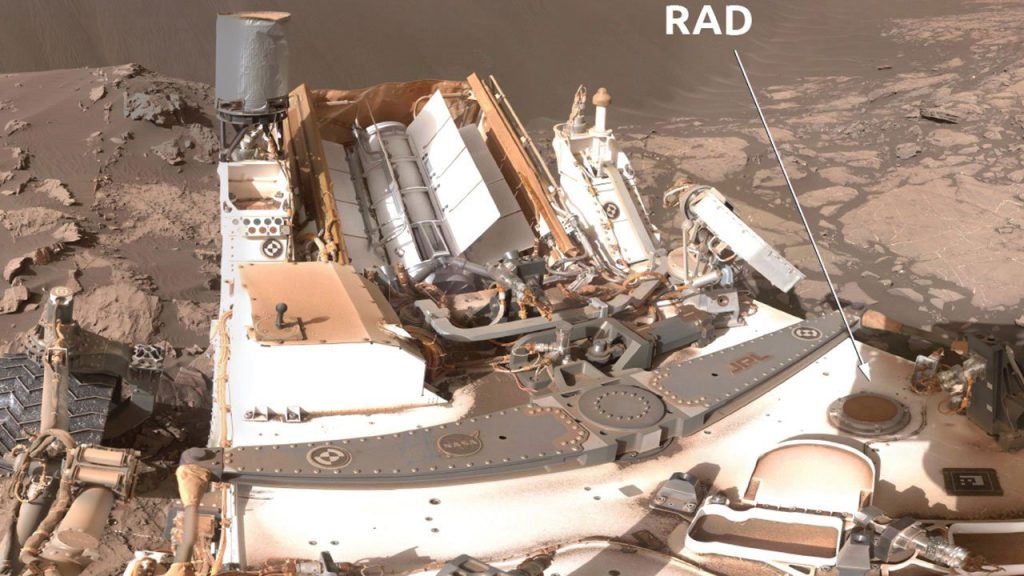 The top of the Radiation Assessment Detector can be seen on the deck of NASA’s Curiosity Mars rover.
The top of the Radiation Assessment Detector can be seen on the deck of NASA’s Curiosity Mars rover.
Credit: NASA/JPL-Caltech/MSSS
RAD has measured the impact of more than a dozen solar storms to date (five while traveling to Mars in 2012), although these past nine years have marked an especially weak period of solar activity.
Scientists are just now starting to see activity pick up as the Sun comes out of its slumber and becomes more active. In fact, RAD observed evidence of the first X-class flare of the new solar cycle on Oct. 28, 2021. X-class flares are the most intense category of solar flares, the largest of which can lead to power outages and communications blackouts on Earth.
“This is an exciting time for us, because one of the important objectives of RAD is to characterize the extremes of space weather. Events such as solar flares and storms are one type of space weather that happens most frequently during increased solar activity – the time we are approaching now,” Ehresmann said. More observations are needed to assess just how dangerous a really powerful solar storm would be to humans on the Martian surface.
RAD’s findings will feed into a much larger body of data being compiled for future crewed missions. In fact, NASA even equipped Curiosity’s counterpart, the Perseverance rover, with samples of spacesuit materials to assess how they hold up to radiation over time.
For more information, please visit the following link
https://www.jpl.nasa.gov/news/how-nasas-curiosity-rover-is-making-mars-safer-for-astronauts
For more information:
https://mars.nasa.gov/msl/home/
and
https://www.nasa.gov/mission_pages/msl/index.html
News Media Contact
Andrew Good
Jet Propulsion Laboratory, Pasadena, Calif.
818-393-2433
Karen Fox / Alana Johnson
NASA Headquarters, Washington
301-286-6284 / 202-358-1501
karen.c.fox@nasa.gov / alana.r.johnson@nasa.gov
2021-226
NASA’s Juno: Science Results Offer First 3D View of Jupiter Atmosphere
Oct 28, 2021
NASA’s Jovian orbiter lends deeper understanding of what happens below the gas giant’s striking clouds.
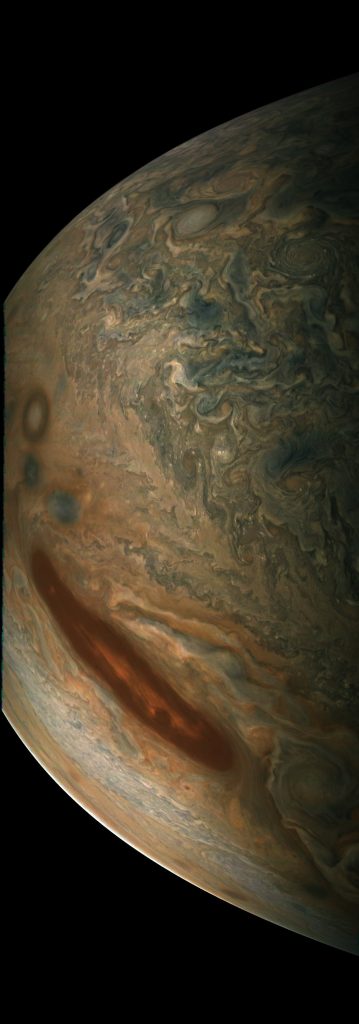 The JunoCam imager aboard NASA’s Juno spacecraft captures a Jovian cyclone known as a barge type in polar jet stream called “Jet N4.”
The JunoCam imager aboard NASA’s Juno spacecraft captures a Jovian cyclone known as a barge type in polar jet stream called “Jet N4.”
Credit: Image data: NASA/JPL-Caltech/SwRI/MSSS. Image processing: Gerald Eichstädt CC BY
New findings from NASA’s Juno probe orbiting Jupiter provide a fuller picture of how the planet’s distinctive and colorful atmospheric features offer clues about the unseen processes below its clouds. The results highlight the inner workings of the belts and zones of clouds encircling Jupiter, as well as its polar cyclones and even the Great Red Spot.
Researchers published several papers on Juno’s atmospheric discoveries today in the journal Science and the Journal of Geophysical Research: Planets. Additional papers appeared in two recent issues of Geophysical Research Letters.
“These new observations from Juno open up a treasure chest of new information about Jupiter’s enigmatic observable features,” said Lori Glaze, director of NASA’s planetary science division at the agency’s headquarters in Washington. “Each paper sheds light on different aspects of the planet’s atmospheric processes – a wonderful example of how our internationally-diverse science teams strengthen understanding of our solar system.”
Juno entered Jupiter’s orbit in 2016. During each of the spacecraft’s 37 passes of the planet to date, a specialized suite of instruments has peered below its turbulent cloud deck.
“Previously, Juno surprised us with hints that phenomena in Jupiter’s atmosphere went deeper than expected,” said Scott Bolton, principal investigator of Juno from the Southwest Research Institute in San Antonio and lead author of the Science journal paper on the depth of Jupiter’s vortices. “Now, we’re starting to put all these individual pieces together and getting our first real understanding of how Jupiter’s beautiful and violent atmosphere works – in 3D.”
Juno’s microwave radiometer (MWR) allows mission scientists to peer beneath Jupiter’s cloud tops and probe the structure of its numerous vortex storms. The most famous of these storms is the iconic anticyclone known as the Great Red Spot. Wider than Earth, this crimson vortex has intrigued scientists since its discovery almost two centuries ago.
The new results show that the cyclones are warmer on top, with lower atmospheric densities, while they are colder at the bottom, with higher densities. Anticyclones, which rotate in the opposite direction, are colder at the top but warmer at the bottom.
The findings also indicate these storms are far taller than expected, with some extending 60 miles (100 kilometers) below the cloud tops and others, including the Great Red Spot, extending over 200 miles (350 kilometers). This surprise discovery demonstrates that the vortices cover regions beyond those where water condenses and clouds form, below the depth where sunlight warms the atmosphere.
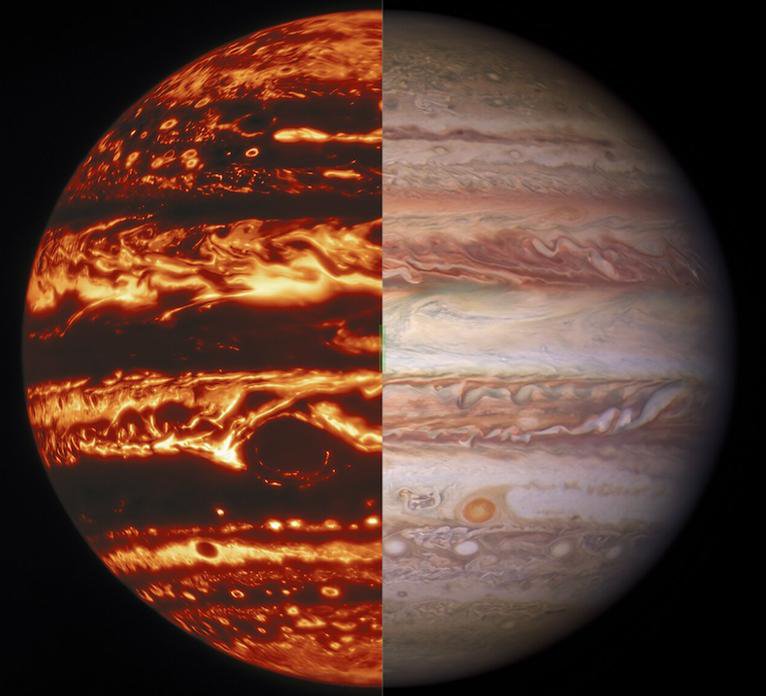 Jupiter’s banded appearance is created by the cloud-forming weather layer. This composite image shows views of Jupiter in infrared and visible light taken by the Gemini North telescope and NASA’s Hubble Space Telescope.
Jupiter’s banded appearance is created by the cloud-forming weather layer. This composite image shows views of Jupiter in infrared and visible light taken by the Gemini North telescope and NASA’s Hubble Space Telescope.
Credit: International Gemini Observatory/NOIRLab/NSF/AURA/NASA/ESA, M.H. Wong and I. de Pater (UC Berkeley) et al.
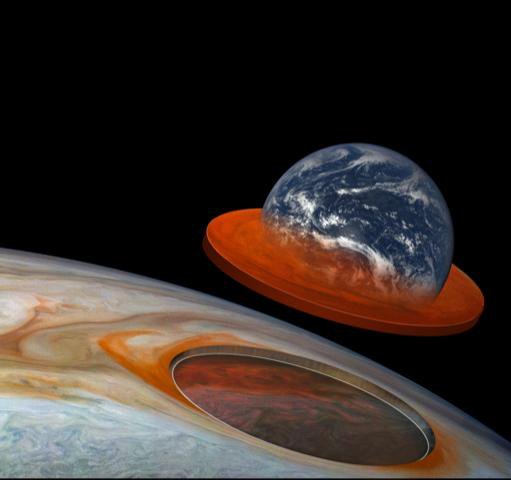 This illustration combines an image of Jupiter from the JunoCam instrument aboard NASA’s Juno spacecraft with a composite image of Earth to depict the size and depth of Jupiter’s Great Red Spot.
This illustration combines an image of Jupiter from the JunoCam instrument aboard NASA’s Juno spacecraft with a composite image of Earth to depict the size and depth of Jupiter’s Great Red Spot.
Credit: JunoCam Image data: NASA/JPL-Caltech/SwRI/MSSSJunoCam Image processing by Kevin M. Gill (CC BY)Earth Image: NASA
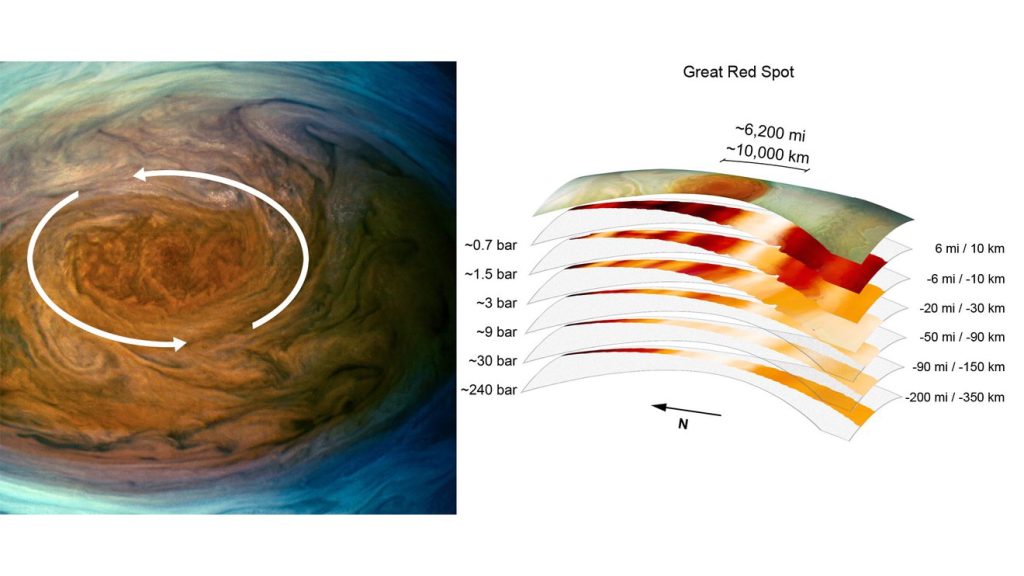 Data collected by the JunoCam imager and microwave radiometer from a flyover of the Great Red Spot on July 11, 2017 provides a glimpse of the inner-workings of Jupiter’s most iconic anticyclone.
Data collected by the JunoCam imager and microwave radiometer from a flyover of the Great Red Spot on July 11, 2017 provides a glimpse of the inner-workings of Jupiter’s most iconic anticyclone.
Credit: NASA/JPL-Caltech/SwRI/MSSS Image processing: Kevin Gill CC BY
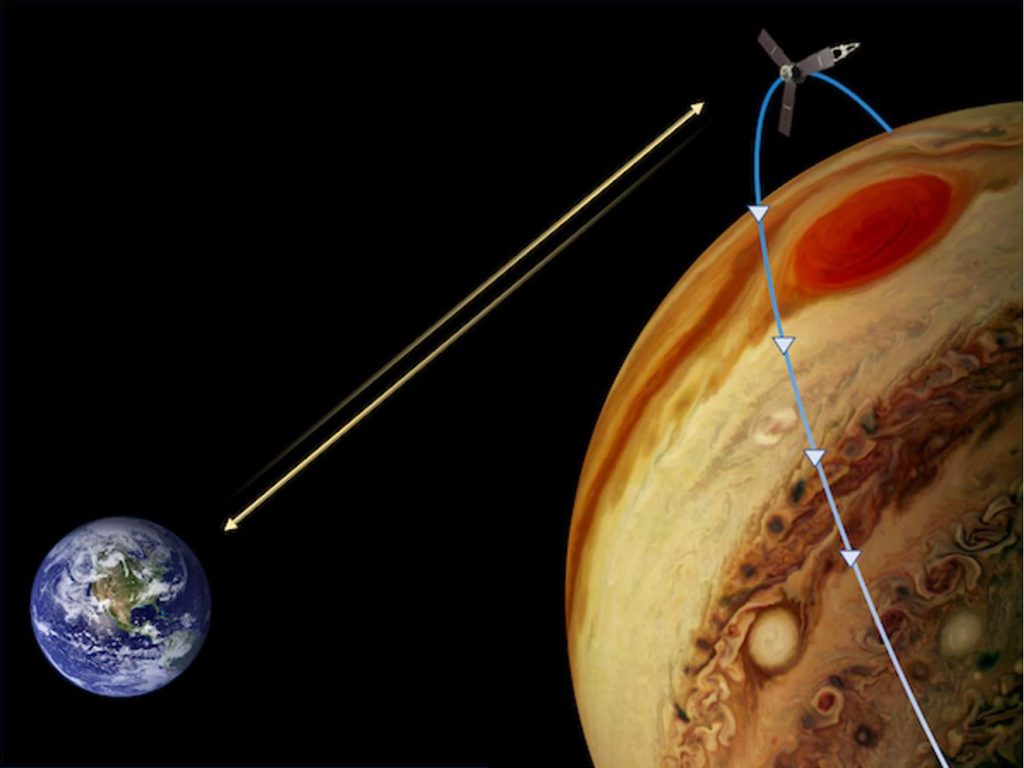 During a flyby of Jupiter in July 2019, mission scientists conducted an experiment measuring minute velocity changes in the Juno spacecraft as a result in the gravity field near the Great Red Spot.
During a flyby of Jupiter in July 2019, mission scientists conducted an experiment measuring minute velocity changes in the Juno spacecraft as a result in the gravity field near the Great Red Spot.
Credit: NASA/JPL-Caltech/SwRI
The height and size of the Great Red Spot means the concentration of atmospheric mass within the storm potentially could be detectable by instruments studying Jupiter’s gravity field. Two close Juno flybys over Jupiter’s most famous spot provided the opportunity to search for the storm’s gravity signature and complement the MWR results on its depth.
With Juno traveling low over Jupiter’s cloud deck at about 130,000 mph (209,000 kph) Juno scientists were able to measure velocity changes as small 0.01 millimeter per second using a NASA Deep Space Network tracking antenna, from a distance of more than 400 million miles (650 million kilometers). This enabled the team to constrain the depth of the Great Red Spot to about 300 miles (500 kilometers) below the cloud tops.
“The precision required to get the Great Red Spot’s gravity during the July 2019 flyby is staggering,” said Marzia Parisi, a Juno scientist from NASA’s Jet Propulsion Laboratory in Southern California and lead author of a paper in the journal Science on gravity overflights of the Great Red Spot. “Being able to complement MWR’s finding on the depth gives us great confidence that future gravity experiments at Jupiter will yield equally intriguing results.”
Belts and Zones
In addition to cyclones and anticyclones, Jupiter is known for its distinctive belts and zones – white and reddish bands of clouds that wrap around the planet. Strong east-west winds moving in opposite directions separate the bands. Juno previously discovered that these winds, or jet streams, reach depths of about 2,000 miles (roughly 3,200 kilometers). Researchers are still trying to solve the mystery of how the jet streams form. Data collected by Juno’s MWR during multiple passes reveal one possible clue: that the atmosphere’s ammonia gas travels up and down in remarkable alignment with the observed jet streams.
“By following the ammonia, we found circulation cells in both the north and south hemispheres that are similar in nature to ‘Ferrel cells,’ which control much of our climate here on Earth,” said Keren Duer, a graduate student from the Weizmann Institute of Science in Israel and lead author of the Science journal paper on Ferrel-like cells on Jupiter. “While Earth has one Ferrel cell per hemisphere, Jupiter has eight – each at least 30 times larger.”
Juno’s MWR data also shows that the belts and zones undergo a transition around 40 miles (65 kilometers) beneath Jupiter’s water clouds. At shallow depths, Jupiter’s belts are brighter in microwave light than the neighboring zones. But at deeper levels, below the water clouds, the opposite is true – which reveals a similarity to our oceans.
“We are calling this level the ‘Jovicline’ in analogy to a transitional layer seen in Earth’s oceans, known as the thermocline – where seawater transitions sharply from being relative warm to relative cold,” said Leigh Fletcher, a Juno participating scientist from the University of Leicester in the United Kingdom and lead author of the paper in the Journal of Geophysical Research: Planets highlighting Juno’s microwave observations of Jupiter’s temperate belts and zones.
Polar Cyclones
Juno previously discovered polygonal arrangements of giant cyclonic storms at both of Jupiter’s poles – eight arranged in an octagonal pattern in the north and five arranged in a pentagonal pattern in the south. Now, five years later, mission scientists using observations by the spacecraft’s Jovian Infrared Auroral Mapper (JIRAM) have determined these atmospheric phenomena are extremely resilient, remaining in the same location.
“Jupiter’s cyclones affect each other’s motion, causing them to oscillate about an equilibrium position,” said Alessandro Mura, a Juno co-investigator at the National Institute for Astrophysics in Rome and lead author of a recent paper in Geophysical Research Letters on oscillations and stability in Jupiter’s polar cyclones. “The behavior of these slow oscillations suggests that they have deep roots.”
JIRAM data also indicates that, like hurricanes on Earth, these cyclones want to move poleward, but cyclones located at the center of each pole push them back. This balance explains where the cyclones reside and the different numbers at each pole.
More About the Mission
JPL, a division of Caltech in Pasadena, California, manages the Juno mission. Juno is part of NASA’s New Frontiers Program, which is managed at NASA’s Marshall Space Flight Center in Huntsville, Alabama, for the agency’s Science Mission Directorate in Washington. Lockheed Martin Space in Denver built and operates the spacecraft.
For more information, please visit the following link
Follow the mission on Facebook and Twitter, and get more information about Juno online at:
Ride With Juno Past the Solar System’s Biggest Moon
NASA’s Juno Mission Expands Into the Future
The Dark Origins of One of Jupiter’s Grand Light Shows
News Media Contact
Karen Fox / Alana Johnson
NASA Headquarters, Washington
301-286-6284 / 202-358-1501
karen.c.fox@nasa.gov / alana.r.johnson@nasa.gov
DC Agle
Jet Propulsion Laboratory, Pasadena, Calif.
818-393-9011
Deb Schmid
Southwest Research Institute, San Antonio
210-522-2254
2021-220
 Catch the premiere of the NASA Jet Propulsion Laboratory documentary “Triumph at Saturn” on Oct. 15 at 3 p.m. PDT online at JPL’s YouTube and Facebook channels.
Catch the premiere of the NASA Jet Propulsion Laboratory documentary “Triumph at Saturn” on Oct. 15 at 3 p.m. PDT online at JPL’s YouTube and Facebook channels.
The latest in the Jet Propulsion Laboratory series of historical documentaries, “Triumph at Saturn” chronicles the story of NASA’s Cassini mission. Part I of this two-part story will premiere on JPL’s YouTube and Facebook channels on Oct. 15 at 3 p.m. PDT; part II will premiere there at the same time on Oct. 22.
These films use rare archival footage and interviews with pioneering engineers and scientists in retelling the story of humanity’s first steps into the cosmos. The films go with 12 others in the series “JPL and the Space Age,” which documents everything from JPL’s origins to the Voyager spacecraft to the Mars Pathfinder mission and beyond. Each episode of was written, produced, and directed by JPL Fellow Blaine Baggett.
The full “Triumph at Saturn” film is planned to be available on this webpage in the near future.
Caltech, in Pasadena, California, manages JPL for NASA.
For more information, please visit the following link
News Media Contact
Gretchen McCartney
Jet Propulsion Laboratory, Pasadena, Calif.
818-393-6215
gretchen.p.mccartney@jpl.nasa.gov
Triumph at Saturn (Part I)
Premiered Oct 15, 2021 NASA Jet Propulsion Laboratory
Chronicling the story of NASA’s Cassini mission, this is the latest in our series of documentaries, “JPL and the Space Age.” These films use rare archival footage and interviews with pioneering engineers and scientists from the Jet Propulsion Laboratory in retelling the stories of many of humanity’s first steps into the cosmos. Part I of this two-part story will premiere here on Oct. 15, 2021 at 3 p.m. Pacific time; part II will premiere here at the same time on Oct. 22: https://youtu.be/oGsajLIALJE. Other films in this series are available for viewing at https://www.jpl.nasa.gov/who-we-are/d…. “Triumph at Saturn” is planned to be added to this collection in the near future.
Get the Latest JPL News
PBS NewsHour full episode, Nov. 19, 2021
Nov 19, 2021 PBS NewsHour
Friday on the NewsHour, Kyle Rittenhouse is cleared on all charges in a case that sparked national debate over racial injustice, guns and self-defense. Then, the U.S. House of Representatives passes the president’s priority Build Back Better bill, sending it on to the Senate. And, why those who were wrongfully convicted still face great struggles when adjusting to their post-prison life. WATCH TODAY’S SEGMENTS: Does the Rittenhouse acquittal set a precedent? https://www.youtube.com/watch?v=qXC56… News Wrap: ‘Unite the Right’ trial jurors begin deliberating https://www.youtube.com/watch?v=awcXo… Child care, climate change and more in Build Back Better Act https://www.youtube.com/watch?v=HiQR-… Here’s what you need to know about COVID boosters https://www.youtube.com/watch?v=UzGm-… How the exonerated struggle to heal from ‘wounds’ of prison https://www.youtube.com/watch?v=umJdh… Capehart and Abernathy on Rittenhouse trial, Dem social bill https://www.youtube.com/watch?v=E2TKH… Stream your PBS favorites with the PBS app: https://to.pbs.org/2Jb8twG Find more from PBS NewsHour at https://www.pbs.org/newshour Subscribe to our YouTube channel: https://bit.ly/2HfsCD6
PBS NewsHour Weekend, Full Episode November 20, 2021
Nov 20, 2021 PBS NewsHour
On this edition for Saturday, November 20th, protests, celebration, and talk of reform after Kyle Rittenhouse was found not guilty on all five charges, new pressure to protect frontline communities from oil and gas drilling in California, and, ‘if at first you don’t succeed’—lessons learned at the Museum of Failure. Hari Sreenivasan anchors from New York. Stream your PBS favorites with the PBS app: https://to.pbs.org/2Jb8twG Find more from PBS NewsHour at https://www.pbs.org/newshour Subscribe to our YouTube channel: https://bit.ly/2HfsCD6
https://www.youtube.com/watch?v=sxOWkd-lTKQ
#NightlyNews #KyleRittenhouse #BoosterShots
Nightly News Full Broadcast – Nov. 19, 2021
Nov 19, 2021 NBC News
Kyle Rittenhouse acquitted on all charges in homicide trial, FDA and CDC authorize 3rd Pfizer, Moderna Covid shots for all adults, and airlines under pressure as millions expected to travel for Thanksgiving. 00:00 Intro 02:08 Kyle Rittenhouse Not Guilty 05:14 Vaccine Boosters For All 07:40 Holiday Travel Trouble 10:53 House Passes Biden Plan 13:56 Charlottesville Jury Deliberations 16:12 The Cost Of Care: Caregiving Financial Toll » Subscribe to NBC News: http://nbcnews.to/SubscribeToNBC » Watch more NBC video: http://bit.ly/MoreNBCNews NBC News Digital is a collection of innovative and powerful news brands that deliver compelling, diverse and engaging news stories. NBC News Digital features NBCNews.com, MSNBC.com, TODAY.com, Nightly News, Meet the Press, Dateline, and the existing apps and digital extensions of these respective properties. We deliver the best in breaking news, live video coverage, original journalism and segments from your favorite NBC News Shows. Connect with NBC News Online! NBC News App: https://smart.link/5d0cd9df61b80 Breaking News Alerts: https://link.nbcnews.com/join/5cj/bre… Visit NBCNews.Com: http://nbcnews.to/ReadNBC Find NBC News on Facebook: http://nbcnews.to/LikeNBC Follow NBC News on Twitter: http://nbcnews.to/FollowNBC #NightlyNews #KyleRittenhouse #BoosterShots
https://www.youtube.com/watch?v=_hwD2cu40y8
Nightly News Full Broadcast – November 20th
Nov 20, 2021 NBC News
Chaos erupts at Atlanta Airport amidst Thanksgiving travel, Protests across the U.S. over Kyle Rittenhouse trial verdict, and CDC greenlights Covid boosters for all adults. » Subscribe to NBC News: http://nbcnews.to/SubscribeToNBC » Watch more NBC video: http://bit.ly/MoreNBCNews NBC News Digital is a collection of innovative and powerful news brands that deliver compelling, diverse and engaging news stories. NBC News Digital features NBCNews.com, MSNBC.com, TODAY.com, Nightly News, Meet the Press, Dateline, and the existing apps and digital extensions of these respective properties. We deliver the best in breaking news, live video coverage, original journalism and segments from your favorite NBC News Shows. Connect with NBC News Online! NBC News App: https://smart.link/5d0cd9df61b80 Breaking News Alerts: https://link.nbcnews.com/join/5cj/bre… Visit NBCNews.Com: http://nbcnews.to/ReadNBC Find NBC News on Facebook: http://nbcnews.to/LikeNBC Follow NBC News on Twitter: http://nbcnews.to/FollowNBC #NightlyNews #AtlantaAirport #KyleRittenhouse #BoosterShots

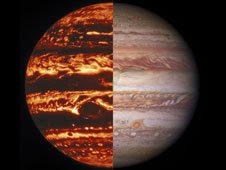
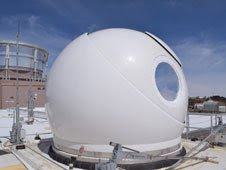

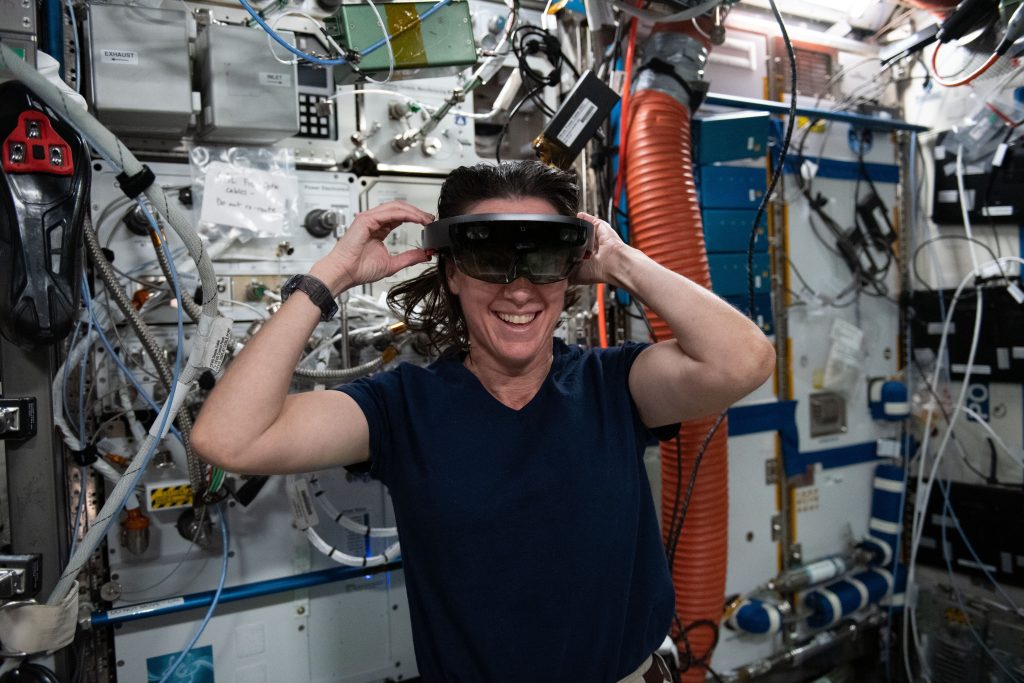
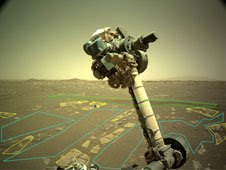


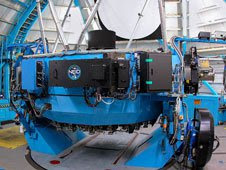
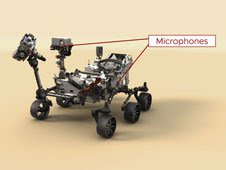
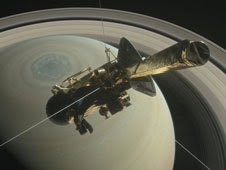



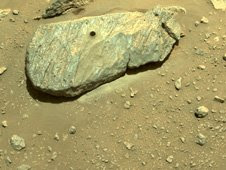
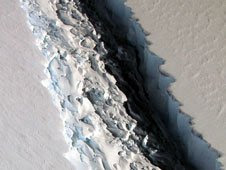
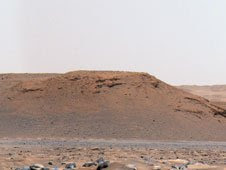


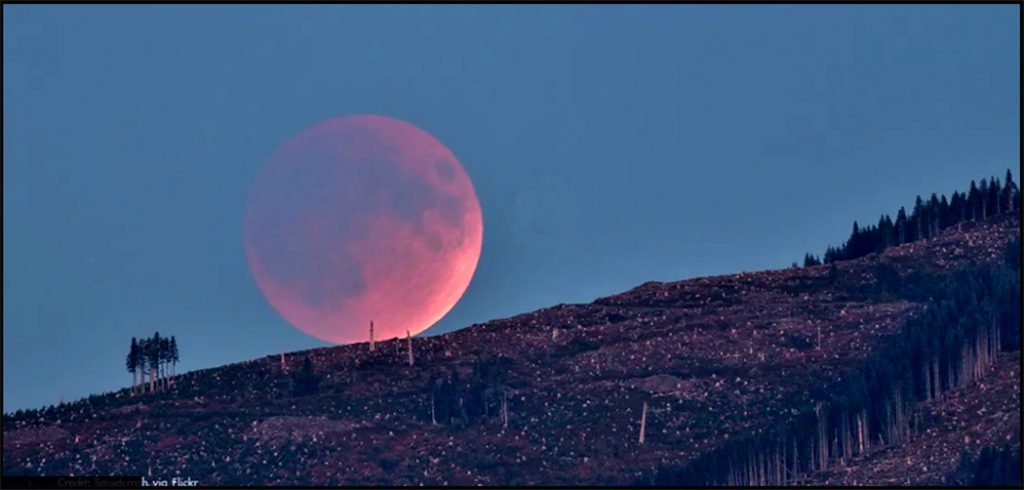
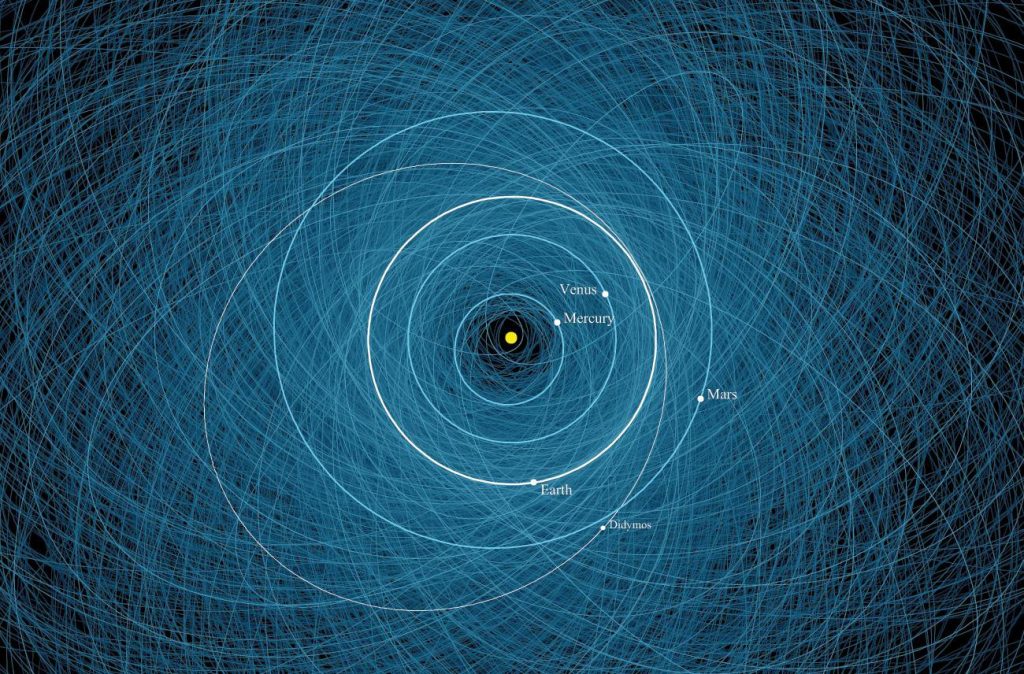
Leave a Reply